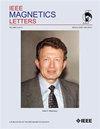铁磁性 Fe3Se4 的摩斯鲍尔和密度函数研究
IF 1.1
4区 物理与天体物理
Q4 ENGINEERING, ELECTRICAL & ELECTRONIC
引用次数: 0
摘要
采用陶瓷法合成了单斜Fe3Se4。研究人员利用莫斯鲍尔光谱学和密度泛函理论研究了其铁磁性和高矫顽力的物理根源。在 78 K 时,观察到 12 条莫斯鲍尔吸收线。这些线由两个子谱 A 和 B 组成,分别对应于 2a 和 4i 位点上的铁原子。在 320 K 时,莫斯鲍尔光谱坍缩,表明铁磁态向顺磁态过渡。这一温度接近文献报道的居里温度(TC)331 或 315 K。对局部结构对称性的分析证实,与 4i 位点的铁原子相比,2a 位点的铁原子与相邻 Se 原子的配位更对称。因此,2a 位点的铁原子比 4i 位点的铁原子表现出更高的超频磁场(HMF)(225 kOe)和更弱的四极分裂(QS)(0.17 mm/s),后者表现出 105 kOe 的 HMF 和 0.55 mm/s 的 QS。我们的密度泛函研究证实,Fe3Se4 具有铁磁性,磁矩为 4.48 µB/u.c.,TC 为 354 K。这一高 Ku 值归因于 4i 位点上的铁原子。根据文献报道,Fe3Se4 的高矫顽力是由于 4i 位点发生了扭曲,从而产生了贾恩-泰勒效应。本文章由计算机程序翻译,如有差异,请以英文原文为准。
Mössbauer and Density Functional Studies of Ferrimagnetic Fe3Se4
Monoclinic Fe
3
Se
4
was synthesized using a ceramic method. Mössbauer spectroscopy and density functional theory were used to investigate the physical origins of its ferrimagnetism and high coercivity. At 78 K, 12 Mössbauer absorption lines were observed. These lines are composed of two subspectra, A and B, corresponding to Fe atoms at the 2
a
and 4
i
sites, respectively. At 320 K, the Mössbauer spectrum collapsed, indicating a transition from a ferrimagnetic to a paramagnetic state. This temperature is close to the Curie temperature (
T
C
) of 331 or 315 K reported in the literature. The analysis of local structural symmetry confirmed that the Fe atoms in the 2
a
sites are more symmetrically coordinated with neighboring Se atoms than those in the 4
i
sites. Therefore, the Fe atoms in the 2
a
sites exhibit a higher hyperfine magnetic field (HMF) of 225 kOe and a weaker quadrupole splitting (QS) of 0.17 mm/s than the Fe atoms in the 4
i
sites, which exhibit an HMF of 105 kOe and a QS of 0.55 mm/s. Our density functional study confirmed that Fe
3
Se
4
exhibits ferrimagnetic behavior, with a magnetic moment of 4.48 µ
B
/u.c. and a
T
C
of 354 K. Fe
3
Se
4
shows a high magnetocrystalline anisotropy constant (
K
u
) of 0.9 × 10
6
erg/cm
3
. This high
K
u
value is attributed to the Fe atoms at the 4
i
sites. It is suggested that the high coercivity of Fe
3
Se
4
, as reported in the literature, is due to the distorted 4
i
site, which experiences the Jahn–Teller effect.
求助全文
通过发布文献求助,成功后即可免费获取论文全文。
去求助
来源期刊

IEEE Magnetics Letters
PHYSICS, APPLIED-
CiteScore
2.40
自引率
0.00%
发文量
37
期刊介绍:
IEEE Magnetics Letters is a peer-reviewed, archival journal covering the physics and engineering of magnetism, magnetic materials, applied magnetics, design and application of magnetic devices, bio-magnetics, magneto-electronics, and spin electronics. IEEE Magnetics Letters publishes short, scholarly articles of substantial current interest.
IEEE Magnetics Letters is a hybrid Open Access (OA) journal. For a fee, authors have the option making their articles freely available to all, including non-subscribers. OA articles are identified as Open Access.
 求助内容:
求助内容: 应助结果提醒方式:
应助结果提醒方式:


